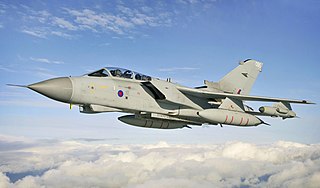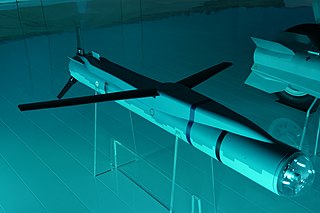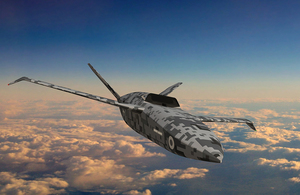
The Lockheed Martin F-35 Lightning II is an American family of single-seat, single-engine, stealth multirole combat aircraft designed for air superiority and strike missions; it also has electronic warfare and intelligence, surveillance, and reconnaissance capabilities. Lockheed Martin is the prime F-35 contractor with principal partners Northrop Grumman and BAE Systems. The aircraft has three main variants: the conventional takeoff and landing (CTOL) F-35A, the short take-off and vertical-landing (STOVL) F-35B, and the carrier-based (CV/CATOBAR) F-35C.

The Saab JAS 39 Gripen is a light single-engine supersonic multirole fighter aircraft manufactured by the Swedish aerospace and defence company Saab AB. The Gripen has a delta wing and canard configuration with relaxed stability design and fly-by-wire flight controls. Later aircraft are fully NATO interoperable. As of 2020, more than 271 Gripens of all models, A–F, have been delivered.

The Eurofighter Typhoon is a European multinational twin-engine, supersonic, canard delta wing, multirole fighter. The Typhoon was designed originally as an air-superiority fighter and is manufactured by a consortium of Airbus, BAE Systems and Leonardo that conducts the majority of the project through a joint holding company, Eurofighter Jagdflugzeug GmbH. The NATO Eurofighter and Tornado Management Agency, representing the UK, Germany, Italy and Spain, manages the project and is the prime customer.

The Panavia Tornado is a family of twin-engine, variable-sweep wing multi-role combat aircraft, jointly developed and manufactured by Italy, the United Kingdom and Germany. There are three primary Tornado variants: the Tornado IDS (interdictor/strike) fighter-bomber, the Tornado ECR SEAD aircraft and the Tornado ADV interceptor aircraft.

The Meteor is a European active radar guided beyond-visual-range air-to-air missile (BVRAAM) developed and manufactured by MBDA. It offers a multi-shot capability, and has the ability to engage highly maneuverable targets such as jet aircraft, and small targets such as UAVs and cruise missiles in a heavy electronic countermeasures (ECM) environment with a range far in excess of 200 kilometres (110 nmi).

The Hellenic Air Force is the air force of Greece. It is considered to be one of the largest air forces in NATO, and is globally placed 18th out of 139 countries. Under the Kingdom of Greece from 1935 to 1973, it was previously known as the Royal Hellenic Air Force (RHAF).

The HAL Tejas is an Indian single-engine, 4.5 generation delta wing multirole combat aircraft designed by the Aeronautical Development Agency (ADA) and manufactured by Hindustan Aeronautics Limited (HAL) for the Indian Air Force (IAF) and Indian Navy. Tejas made its first flight in 2001 and entered into service with the IAF in 2015. In 2003, the aircraft was officially named 'Tejas'. Currently Tejas is the smallest and lightest in its class of supersonic combat aircraft.

The Future Combat Air System (FCAS), is a European combat system of systems under development by Dassault Aviation, Airbus and Indra Sistemas. The FCAS will consist of a Next-Generation Weapon System (NGWS) as well as other air assets in the future operational battlespace. The NGWS's components will be remote carrier vehicles as well as a New Generation Fighter (NGF) - a sixth-generation jet fighter that by around 2045 will replace current France's Rafales, Germany's Typhoons and Spain's EF-18 Hornets.
The planning for the future of the Royal Air Force involves supporting ongoing British military operations, the introduction of new aircraft types including unmanned aerial vehicles, greater focus on network enabled capability and increasing interoperability with members of NATO, team tempest, and mixed crewed fighters. From the updated plans of the RAF (2021) state that the new initiative will focus on becoming carbon net-zero, with strategies such as using sustainable aviation fuels in aircraft. The RAF also are looking into investing in the maintenance of the aircraft to ensure success of future operations.
A sixth-generation fighter is a conceptualized class of jet fighter aircraft design more advanced than the fifth-generation jet fighters that are currently in service and development. Several countries have announced the development of a national sixth-generation aircraft program, including the United States, Russia and China, while Japan, Italy, the United Kingdom, France, Germany, Spain, and Sweden have joined together in collaborative multinational programs in an effort to spread development costs. The first sixth-generation fighters are expected to enter service in the 2030s.

Lockheed Martin F-35 Lightning II procurement is the planned selection and purchase of the Lockheed Martin F-35 Lightning II, also known as the Joint Strike Fighter (JSF) by various countries.

The Dassault Rafale is a French twin-engine, canard delta wing, multirole fighter aircraft designed and built by Dassault Aviation. Equipped with a wide range of weapons, the Rafale is intended to perform air supremacy, interdiction, aerial reconnaissance, ground support, in-depth strike, anti-ship strike and nuclear deterrence missions. It is referred to as an "omnirole" 4.5th generation aircraft by Dassault.
The Flygsystem 2020 is an ongoing project by the Swedish Air Force to develop a fifth-generation low-observable fighter jet by 2035. Little public information exists about the project; there are no official statements about the current stage of development, although a video claims to show a miniature prototype test. In 2012, Lieutenant Colonel Lars Helmrich of the Swedish Air Force asked members of the Riksdag to consider the development of a new jet fighter or to upgrade all present JAS 39 multirole fighters to the NG model, claiming the early versions of the aircraft will be obsolete by 2020.

Éric Trappier is a French businessman and engineer. Since January 2013, he has been the chief executive officer of French aircraft manufacturer Dassault Aviation, a subsidiary of the Dassault Group.

The Select Precision Effects At Range (SPEAR) Capability 3, or simply referred to as SPEAR 3 is a future British air-to-ground and possibly anti-ship cruise missile that could also be considered a loitering munition. It is currently planned to be integrated on the Eurofighter Typhoon, F-35B Lightning and possibly Tempest.
The Future Offensive Air System was a study to replace the Royal Air Force's strike capability, at the time provided by the Tornado GR4. Initial operational capability was expected around 2017. The FOAS was cancelled in June 2005 and was replaced by the Deep and Persistent Offensive Capability (DPOC) requirement, which was itself cancelled in the 2010 Strategic Defence and Security Review.

The BAE Systems Tempest is a proposed sixth-generation fighter aircraft that is under development in the United Kingdom for the Royal Air Force (RAF). The aircraft is intended to enter service from 2035, gradually replacing the Eurofighter Typhoon. It is being developed as part of the Future Combat Air System (FCAS) programme by a consortium known as Team Tempest, which includes the Ministry of Defence, BAE Systems, Rolls-Royce, Leonardo, and MBDA UK. £2 billion is planned to be spent by the British government on the initial phase of the project up to 2025.
Eurofighter Typhoon procurement is the planned selection and purchase of the Eurofighter Typhoon jet fighter by various countries.
MBDA UK is the British division of the pan-European missile systems company MBDA. Formed in 2001, the company has developed, both independently and in cooperation, a range of missile systems, including the CAMM missile family, Storm Shadow cruise missile, ASRAAM air-to-air missile and Meteor beyond-visual-range missile (BVRAAM).

The Spirit Mosquito was an unmanned combat aerial vehicle (UCAV) technology demonstrator in development by Team Mosquito in the United Kingdom. In January 2021, the aircraft was chosen as a technology demonstrator for the Royal Air Force's Lightweight Affordable Novel Combat Aircraft (LANCA) concept which was first conceptualised in 2015 by the RAF Rapid Capabilities Office.
















